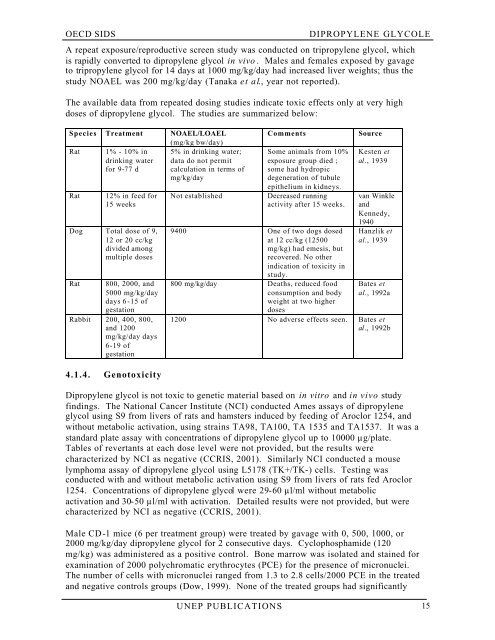Dipropylene glycol (SIDS)
Dipropylene glycol (SIDS)
Dipropylene glycol (SIDS)
You also want an ePaper? Increase the reach of your titles
YUMPU automatically turns print PDFs into web optimized ePapers that Google loves.
OECD <strong>SIDS</strong><br />
DIPROPYLENE GLYCOLE<br />
A repeat exposure/reproductive screen study was conducted on tripropylene <strong>glycol</strong>, which<br />
is rapidly converted to dipropylene <strong>glycol</strong> in vivo . Males and females exposed by gavage<br />
to tripropylene <strong>glycol</strong> for 14 days at 1000 mg/kg/day had increased liver weights; thus the<br />
study NOAEL was 200 mg/kg/day (Tanaka et al., year not reported).<br />
The available data from repeated dosing studies indicate toxic effects only at very high<br />
doses of dipropylene <strong>glycol</strong>. The studies are summarized below:<br />
Species Treatment NOAEL/LOAEL<br />
(mg/kg bw/day)<br />
Rat 1% - 10% in 5% in drinking water;<br />
drinking water data do not permit<br />
for 9-77 d calculation in terms of<br />
mg/kg/day<br />
Rat<br />
12% in feed for<br />
15 weeks<br />
Dog Total dose of 9,<br />
12 or 20 cc/kg<br />
divided among<br />
multiple doses<br />
Rat 800, 2000, and<br />
5000 mg/kg/day<br />
days 6-15 of<br />
gestation<br />
Rabbit 200, 400, 800,<br />
and 1200<br />
mg/kg/day days<br />
6-19 of<br />
gestation<br />
4.1.4. Genotoxicity<br />
Not established<br />
Comments<br />
Some animals from 10%<br />
exposure group died ;<br />
some had hydropic<br />
degeneration of tubule<br />
epithelium in kidneys.<br />
Decreased running<br />
activity after 15 weeks.<br />
9400 One of two dogs dosed<br />
at 12 cc/kg (12500<br />
mg/kg) had emesis, but<br />
recovered. No other<br />
indication of toxicity in<br />
study.<br />
800 mg/kg/day Deaths, reduced food<br />
consumption and body<br />
weight at two higher<br />
doses<br />
Source<br />
Kesten et<br />
al., 1939<br />
van Winkle<br />
and<br />
Kennedy,<br />
1940<br />
Hanzlik et<br />
al., 1939<br />
Bates et<br />
al., 1992a<br />
1200 No adverse effects seen. Bates et<br />
al., 1992b<br />
<strong>Dipropylene</strong> <strong>glycol</strong> is not toxic to genetic material based on in vitro and in vivo study<br />
findings. The National Cancer Institute (NCI) conducted Ames assays of dipropylene<br />
<strong>glycol</strong> using S9 from livers of rats and hamsters induced by feeding of Aroclor 1254, and<br />
without metabolic activation, using strains TA98, TA100, TA 1535 and TA1537. It was a<br />
standard plate assay with concentrations of dipropylene <strong>glycol</strong> up to 10000 µg/plate.<br />
Tables of revertants at each dose level were not provided, but the results were<br />
characterized by NCI as negative (CCRIS, 2001). Similarly NCI conducted a mouse<br />
lymphoma assay of dipropylene <strong>glycol</strong> using L5178 (TK+/TK-) cells. Testing was<br />
conducted with and without metabolic activation using S9 from livers of rats fed Aroclor<br />
1254. Concentrations of dipropylene <strong>glycol</strong> were 29-60 µl/ml without metabolic<br />
activation and 30-50 µl/ml with activation. Detailed results were not provided, but were<br />
characterized by NCI as negative (CCRIS, 2001).<br />
Male CD-1 mice (6 per treatment group) were treated by gavage with 0, 500, 1000, or<br />
2000 mg/kg/day dipropylene <strong>glycol</strong> for 2 consecutive days. Cyclophosphamide (120<br />
mg/kg) was administered as a positive control. Bone marrow was isolated and stained for<br />
examination of 2000 polychromatic erythrocytes (PCE) for the presence of micronuclei.<br />
The number of cells with micronuclei ranged from 1.3 to 2.8 cells/2000 PCE in the treated<br />
and negative controls groups (Dow, 1999). None of the treated groups had significantly<br />
UNEP PUBLICATIONS 15
















